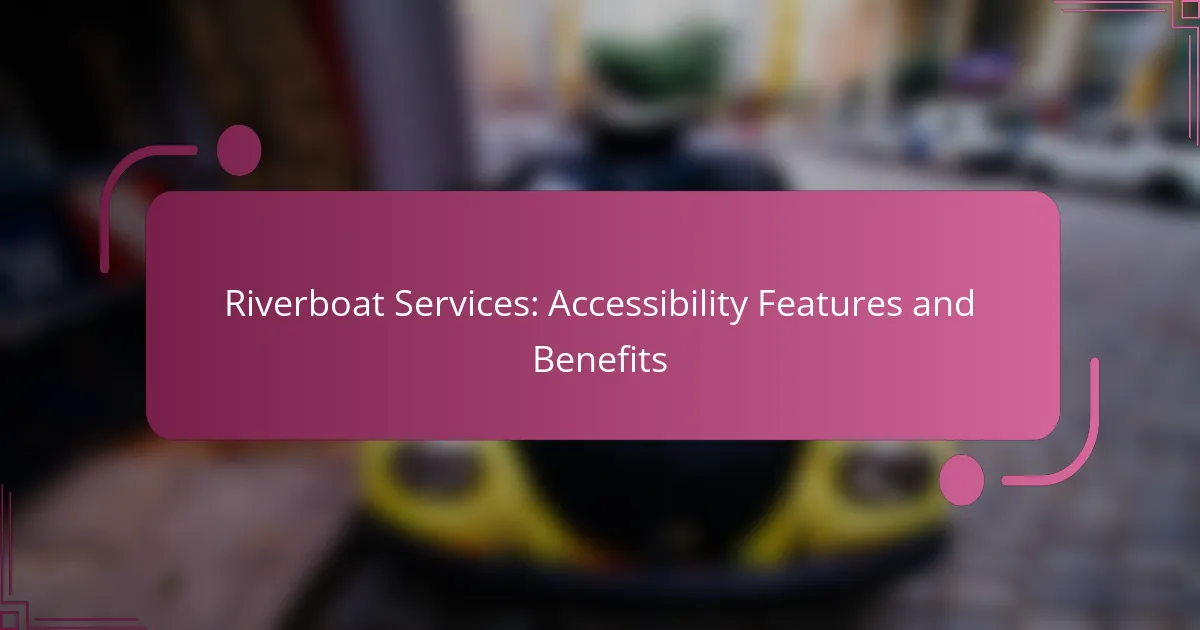Riverboat services are committed to inclusivity, offering a range of accessibility features that cater to passengers with disabilities and seniors. These enhancements, such as priority boarding and comfortable seating, ensure that all guests can enjoy a safe and pleasant travel experience on the water. By fostering an accommodating environment, riverboat services promote participation and enjoyment for everyone, making river travel accessible to all.
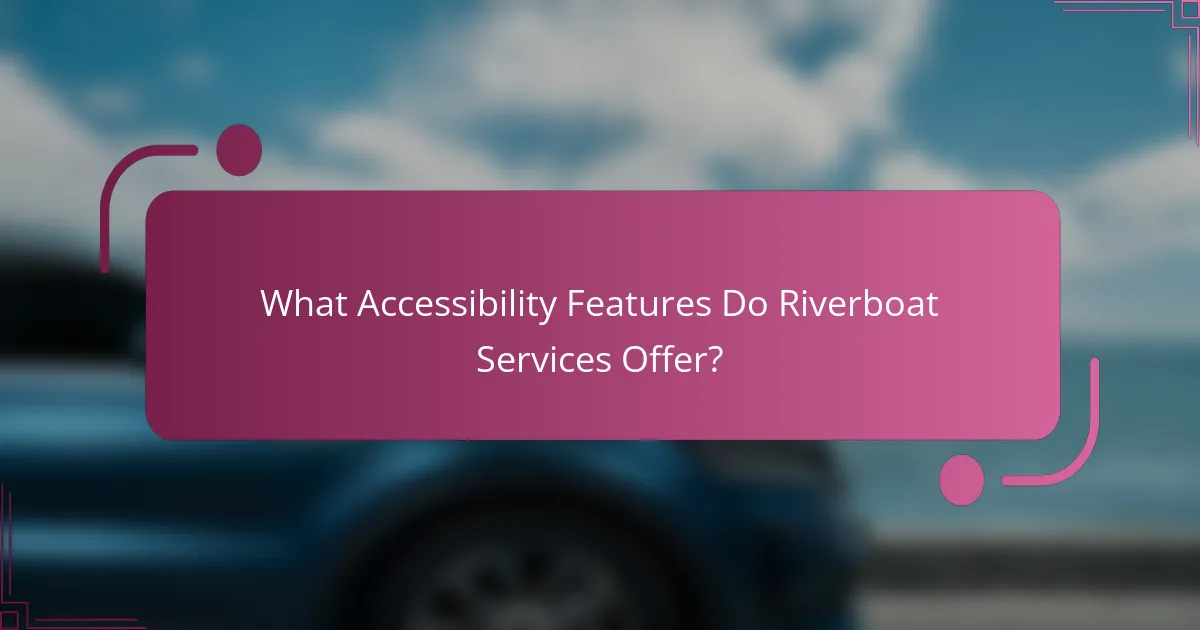
What Accessibility Features Do Riverboat Services Offer?
Riverboat services provide various accessibility features designed to accommodate passengers with disabilities. These features enhance the travel experience by ensuring that all guests can navigate the vessel comfortably and safely.
Wheelchair ramps
Wheelchair ramps are essential for providing easy access to riverboats. These ramps are typically located at the gangway and are designed to accommodate various mobility devices, ensuring that passengers can board and disembark without difficulty.
When using a riverboat, check the specifications of the ramps, as some may have weight limits or incline angles that could affect usability. It’s advisable to contact the service provider in advance to confirm the availability and condition of these ramps.
Accessible restrooms
Accessible restrooms on riverboats are equipped with features that facilitate use by individuals with disabilities. These restrooms often include grab bars, wider stalls, and accessible sinks to ensure comfort and safety.
Before your trip, inquire about the number and location of accessible restrooms on the vessel. This information can help you plan your journey more effectively and avoid any inconvenience during your travel.
Visual and auditory aids
Riverboat services often include visual and auditory aids to assist passengers with sensory impairments. These aids may consist of signage in large print or Braille, as well as announcements made over the PA system to inform guests about important information.
It’s beneficial to ask about the specific aids available on the riverboat you plan to use. Knowing what resources are at your disposal can enhance your overall experience and ensure you stay informed throughout your journey.
Designated seating areas
Designated seating areas are reserved for passengers with disabilities, providing them with comfortable and accessible options during the trip. These areas are typically located near exits and restrooms for convenience.
When booking your tickets, request seating in these designated areas to ensure you have the necessary space and accessibility. This can help avoid crowded conditions and make your travel experience more enjoyable.
Assistance from staff
Staff assistance is a crucial aspect of accessibility on riverboats. Trained personnel are available to help passengers with boarding, navigating the vessel, and addressing any specific needs that may arise during the journey.
Before your trip, communicate any special requirements you may have to the riverboat service. This proactive approach allows staff to prepare and provide the best possible support during your travel experience.
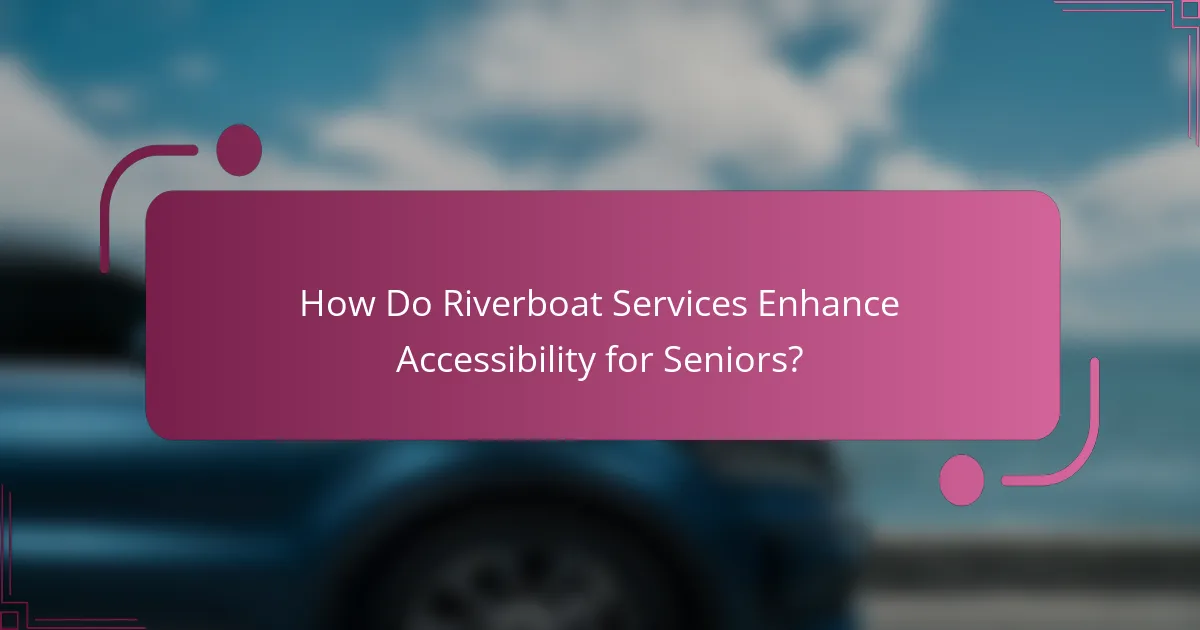
How Do Riverboat Services Enhance Accessibility for Seniors?
Riverboat services enhance accessibility for seniors by providing tailored features that ensure comfort and ease of use. These services focus on priority boarding, comfortable seating options, and guided assistance, making travel more enjoyable and manageable for older adults.
Priority boarding
Priority boarding allows seniors to embark and disembark from riverboats without the stress of long queues. This feature is particularly beneficial for those with mobility challenges, as it ensures they can access the vessel at their own pace.
Many riverboat operators offer designated boarding times for seniors, often allowing them to board before other passengers. This not only reduces wait times but also provides a more relaxed atmosphere as seniors can settle in comfortably before the journey begins.
Comfortable seating options
Comfortable seating options are essential for seniors, who may require additional support during their travels. Riverboats typically provide a variety of seating arrangements, including cushioned chairs and spaces that accommodate mobility aids like walkers or wheelchairs.
Some services even offer adjustable seating to cater to individual preferences, ensuring that seniors can find a position that minimizes discomfort. It’s advisable to check with the riverboat service in advance to reserve suitable seating that meets specific needs.
Guided assistance
Guided assistance is a vital feature that enhances the overall experience for seniors on riverboats. Staff members are often trained to provide help with boarding, navigating the vessel, and addressing any special requirements that may arise during the trip.
Many riverboat services encourage seniors to inform them of any assistance needed prior to departure. This proactive approach ensures that staff can be prepared and available to offer support, making the journey smoother and more enjoyable for older passengers.
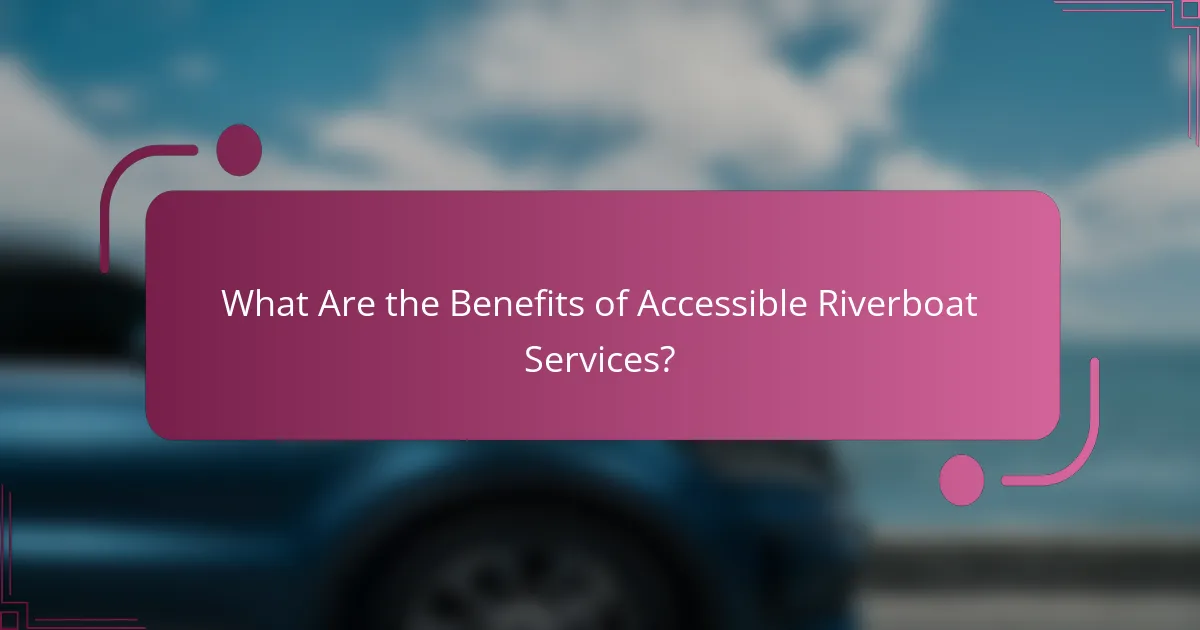
What Are the Benefits of Accessible Riverboat Services?
Accessible riverboat services provide significant advantages by ensuring that individuals with disabilities can enjoy river travel. These services enhance participation, enjoyment, and inclusivity for all community members, fostering a more welcoming environment on the water.
Increased participation
Accessible riverboat services lead to increased participation by allowing individuals with mobility challenges to engage in recreational activities. Features such as ramps, designated seating, and accessible restrooms ensure that everyone can board and enjoy the journey without barriers.
For example, riverboat operators might implement specific programs or events tailored for people with disabilities, encouraging more individuals to join in. This not only boosts attendance but also enriches the overall experience for all passengers.
Enhanced enjoyment
When riverboat services are accessible, they enhance enjoyment for all passengers, including those with disabilities. Accessible features such as audio descriptions, tactile maps, and sensory-friendly environments cater to diverse needs, making the experience more enjoyable.
Moreover, providing trained staff who understand how to assist passengers with various disabilities can significantly improve comfort levels. This attention to detail ensures that everyone can relax and fully appreciate the scenic views and onboard activities.
Community inclusivity
Accessible riverboat services promote community inclusivity by creating opportunities for social interaction among diverse groups. When everyone can participate, it fosters a sense of belonging and strengthens community ties.
Riverboat operators can collaborate with local organizations to host inclusive events, such as themed cruises or educational outings that cater to all abilities. This not only benefits individuals with disabilities but also enriches the community as a whole by encouraging understanding and cooperation among all members.

What Regulations Govern Accessibility in Riverboat Services?
Accessibility in riverboat services is primarily governed by federal and local regulations that ensure equal access for individuals with disabilities. The Americans with Disabilities Act (ADA) sets the baseline for accessibility standards, while local laws may introduce additional requirements tailored to specific regions.
Americans with Disabilities Act (ADA)
The ADA mandates that all public transportation services, including riverboats, must be accessible to individuals with disabilities. This includes requirements for accessible boarding, seating, and restroom facilities, ensuring that all passengers can navigate the vessel safely and comfortably.
Riverboat operators must provide features such as ramps, designated seating areas, and clear signage to assist passengers with mobility impairments. Compliance with the ADA not only enhances accessibility but also helps operators avoid potential legal issues related to discrimination.
Local accessibility standards
In addition to the ADA, local accessibility standards may apply, which can vary significantly by state or municipality. These regulations might include specific design features or operational practices that exceed federal requirements, reflecting the unique needs of the local population.
For example, some regions may require additional training for staff on assisting passengers with disabilities or mandate the availability of specialized equipment. Riverboat operators should familiarize themselves with these local regulations to ensure full compliance and provide the best possible service to all passengers.
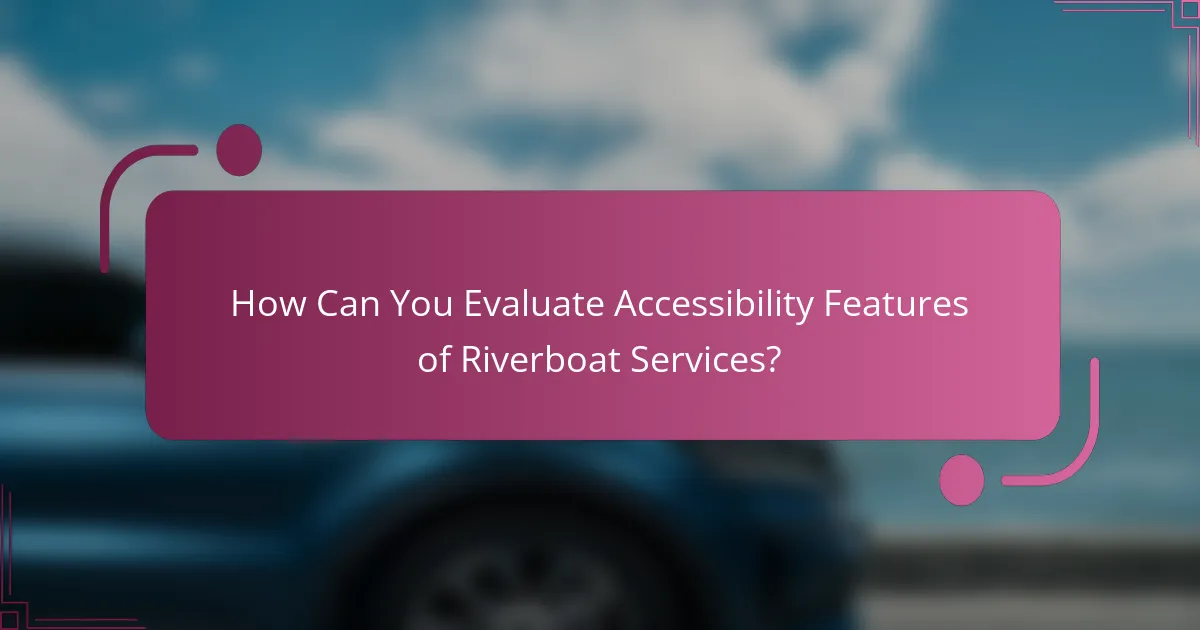
How Can You Evaluate Accessibility Features of Riverboat Services?
To evaluate accessibility features of riverboat services, consider the specific accommodations available for passengers with disabilities, such as wheelchair access, accessible restrooms, and assistance services. Assessing these features can help ensure a comfortable and enjoyable experience on the water.
Customer reviews
Customer reviews can provide valuable insights into the accessibility of riverboat services. Look for feedback from passengers who have specific accessibility needs, as their experiences can highlight both strengths and weaknesses of the service. Pay attention to comments regarding staff assistance, the condition of accessible facilities, and overall satisfaction.
Online platforms such as travel websites and social media can be useful for gathering these reviews. Focus on recent feedback to ensure the information reflects current conditions and services.
Accessibility checklists
Using accessibility checklists can help you systematically evaluate riverboat services. These checklists typically include criteria such as the availability of ramps, elevators, designated seating, and accessible emergency procedures. A thorough checklist can guide your assessment and ensure no important features are overlooked.
Consider creating a personalized checklist based on your specific needs. This can include questions about the availability of assistance during boarding and disembarking, as well as the presence of staff trained in accessibility support. Comparing multiple riverboat services using your checklist can help you make an informed decision.

What Are the Costs Associated with Enhancing Accessibility?
Enhancing accessibility on riverboats involves various costs, including initial investments for modifications and ongoing maintenance expenses. Understanding these costs is crucial for operators aiming to comply with regulations and improve passenger experience.
Initial investment for modifications
The initial investment for accessibility modifications can vary significantly based on the extent of changes required. Basic upgrades, such as installing ramps and accessible restrooms, may range from a few thousand to tens of thousands of USD, depending on the riverboat’s size and existing infrastructure.
When planning these modifications, consider the specific needs of passengers with disabilities. For instance, adding features like designated seating areas or tactile signage can enhance usability but will increase upfront costs. It’s advisable to consult with accessibility experts to ensure compliance with standards such as the Americans with Disabilities Act (ADA) in the U.S.
Ongoing maintenance costs
Ongoing maintenance costs for accessibility features are essential to keep them functional and safe. Regular inspections and repairs of ramps, lifts, and accessible restrooms can add several hundred to a few thousand USD annually, depending on usage and wear.
Operators should budget for routine maintenance and potential upgrades as technology and regulations evolve. Establishing a maintenance schedule can help prevent larger, unexpected expenses and ensure that accessibility features remain effective for all passengers.

What Emerging Trends Are Shaping Accessibility in Riverboat Services?
Emerging trends in accessibility for riverboat services focus on enhancing the experience for passengers with disabilities. Innovations in design, technology, and regulatory compliance are making riverboat travel more inclusive and user-friendly.
Innovative Design Features
Modern riverboats are increasingly incorporating innovative design features to improve accessibility. This includes wider doorways, ramps instead of stairs, and designated seating areas for passengers with mobility challenges. These design elements not only comply with regulations but also enhance comfort and ease of movement on board.
For example, some riverboats now feature adjustable railings and tactile pathways to assist visually impaired passengers. These enhancements ensure that all guests can navigate the vessel safely and independently.
Technology Integration
Technology plays a significant role in improving accessibility in riverboat services. Many operators are adopting assistive technologies such as audio guides, mobile apps, and real-time information systems that cater to the needs of passengers with disabilities. These tools help passengers plan their journey and receive updates on accessibility features.
For instance, apps that provide information on accessible routes and services onboard can greatly enhance the travel experience. Additionally, some riverboats are equipped with smart technology that allows passengers to control lighting and climate settings from their seats.
Regulatory Compliance and Standards
Compliance with accessibility regulations is becoming a priority for riverboat services. In many regions, operators must adhere to standards set by organizations such as the Americans with Disabilities Act (ADA) in the United States or similar regulations in Europe. These standards ensure that riverboats provide necessary accommodations for passengers with disabilities.
Operators are increasingly conducting audits to assess their compliance and identify areas for improvement. This proactive approach not only meets legal requirements but also enhances the overall guest experience, fostering a more inclusive environment.
